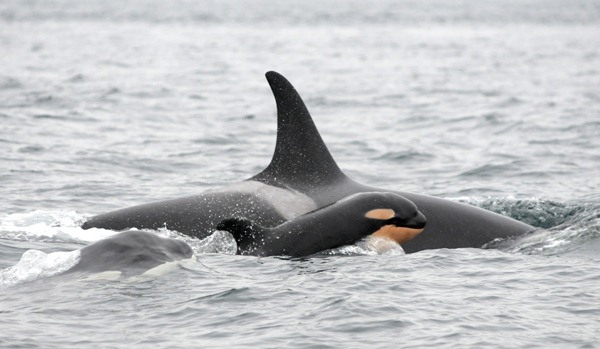— Submitted by Center for Whale Research
After spending most of the summer in the San Juan Islands and Georgia Strait, Southern Resident orca pods are likely to show up any day now venturing south into Puget Sound for the fall and early winter months. They typically travel down Admiralty Inlet to south of Vashon Island chasing chum salmon runs beginning in October.
And this year, there will be six new family members with them, the newest being J53, first observed Oct. 25! After two and a half years with no new calves being born to this endangered community of orcas, these six new orca calves are a welcome delight and we look forward to seeing them swimming into Puget Sound this season.
The mammal-eating Transient (Biggs) orcas are also often seen year around in Puget Sound; and for the last several months there have been six to eight Humpback whales feeding in the inland waters, a sign of their population increasing and repopulating historic habitat.
Since the 2005 Federal listing of the Southern Resident Orcas under the Endangered Species Act, Orca Network has been assisting NOAA Fisheries and the Center for Whale Research to help track the orcas’ winter travels in Puget Sound and along the outer coast.
Orca Network has trained over 50 volunteer whale observer/naturalists from Island, Snohomish, King, Kitsap, Pierce, and Thurston counties. “Our volunteers are provided with up to date ID guides and information to share with others while viewing whales from the shoreline, to educate about the orcas, their habitat, and prey,” said Whale Sighting Network Coordinator Alisa Lemire Brooks.
This time of year offers wonderful opportunities to observe orcas from the many miles of shoreline on Whidbey Island, the Kitsap and Olympic Peninsulas, and the inland waters of Puget Sound. For fifteen years, Orca Network’s Whale Sighting Network has encouraged whale watching from shore, or from Washington State Ferries in the inland waters.
The Orca Network website shows recent whale sightings as well as archives back to 2001, and now includes the new Sighting Viewpoints map for volunteers and citizens to use to see whales from land-based viewpoints around the Sound, with descriptions of over 100 public viewing locations and directions to help find them.
The map, based on a Google map that can be zoomed in to each location, can be accessed from:www.orcanetwork.org/Viewpoints.html. The map and current sightings are also displayed at Orca Network’s Langley Whale Center at our new location, 115 Anthes, Langley, Whidbey Island.
Observers can help by calling in any whale sighting immediately and when possible photographing the whales to help provide IDs. Whale reports may be called in to our toll-free number: 1-866-ORCANET, emailed toinfo@orcanetwork.org, or posted on our Orca Network Facebook page: www.facebook.com/OrcaNetwork.
Whale sightings from the public provide critical information about the travels of the whales, and timely reports enable Orca Network to alert researchers who can then obtain photo identification and prey and fecal samples from the whales during their visits into Puget Sound. Please include the species, location, time, direction of travel, and approximate number of whales. Also include any behaviors you may observe (breaching, spy-hops, feeding, etc).Â
All sightings are in turn shared with researchers, agencies, and the public through our Whale Sightings Email list, Orca Network website and Facebook and Twitter pages, and at our Langley Whale Center.
The Whale Sighting Network, Langley Whale Center and Orca Network website and Facebook Page also provide up to date information on the latest research and issues related to orcas, salmon, other cetaceans and their habitats, along with federal whale watching regulations and Be Whale Wise guidelines for viewing marine mammals (www.BeWhaleWise.org).
To be on our Whale Sighting Network Email List and receive whale sighting information to improve your chances of observing whales off our shorelines, sign up on our website: www.orcanetwork.org.
Orca Network’s Howard Garrett says, “We are very fortunate to live in a place where we can look out from nearby shorelines and see those majestic black fins parting the waters. Nowhere else in the world are not just one, but two completely different types of orcas seen regularly from shore in populated areas. We are thankful for the hundreds of citizens who report sightings each year, providing valuable data to help in recovery efforts for the endangered Southern Resident orcas.”



